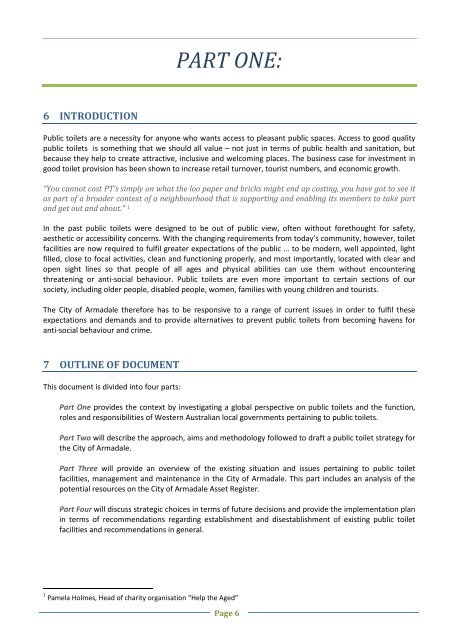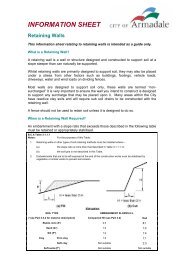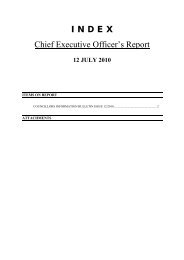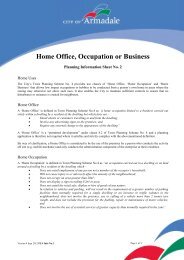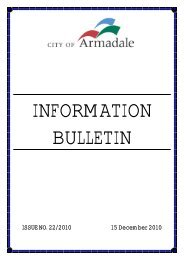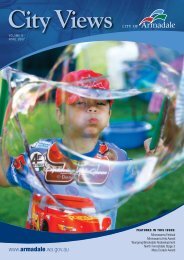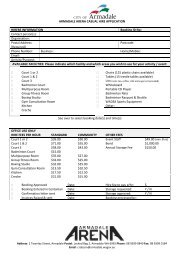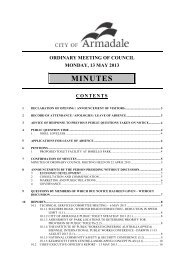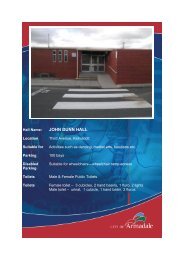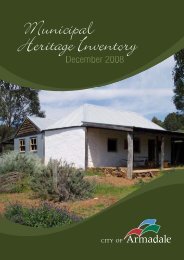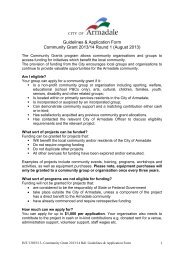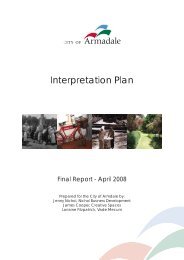Public Toilet Strategy 2013 - City of Armadale
Public Toilet Strategy 2013 - City of Armadale
Public Toilet Strategy 2013 - City of Armadale
You also want an ePaper? Increase the reach of your titles
YUMPU automatically turns print PDFs into web optimized ePapers that Google loves.
PART ONE:<br />
6 INTRODUCTION<br />
<strong>Public</strong> toilets are a necessity for anyone who wants access to pleasant public spaces. Access to good quality<br />
public toilets is something that we should all value – not just in terms <strong>of</strong> public health and sanitation, but<br />
because they help to create attractive, inclusive and welcoming places. The business case for investment in<br />
good toilet provision has been shown to increase retail turnover, tourist numbers, and economic growth.<br />
“You cannot cost PT’s simply on what the loo paper and bricks might end up costing, you have got to see it<br />
as part <strong>of</strong> a broader context <strong>of</strong> a neighbourhood that is supporting and enabling its members to take part<br />
and get out and about.” 1<br />
In the past public toilets were designed to be out <strong>of</strong> public view, <strong>of</strong>ten without forethought for safety,<br />
aesthetic or accessibility concerns. With the changing requirements from today’s community, however, toilet<br />
facilities are now required to fulfil greater expectations <strong>of</strong> the public … to be modern, well appointed, light<br />
filled, close to focal activities, clean and functioning properly, and most importantly, located with clear and<br />
open sight lines so that people <strong>of</strong> all ages and physical abilities can use them without encountering<br />
threatening or anti-social behaviour. <strong>Public</strong> toilets are even more important to certain sections <strong>of</strong> our<br />
society, including older people, disabled people, women, families with young children and tourists.<br />
The <strong>City</strong> <strong>of</strong> <strong>Armadale</strong> therefore has to be responsive to a range <strong>of</strong> current issues in order to fulfil these<br />
expectations and demands and to provide alternatives to prevent public toilets from becoming havens for<br />
anti-social behaviour and crime.<br />
7 OUTLINE OF DOCUMENT<br />
This document is divided into four parts:<br />
Part One provides the context by investigating a global perspective on public toilets and the function,<br />
roles and responsibilities <strong>of</strong> Western Australian local governments pertaining to public toilets.<br />
Part Two will describe the approach, aims and methodology followed to draft a public toilet strategy for<br />
the <strong>City</strong> <strong>of</strong> <strong>Armadale</strong>.<br />
Part Three will provide an overview <strong>of</strong> the existing situation and issues pertaining to public toilet<br />
facilities, management and maintenance in the <strong>City</strong> <strong>of</strong> <strong>Armadale</strong>. This part includes an analysis <strong>of</strong> the<br />
potential resources on the <strong>City</strong> <strong>of</strong> <strong>Armadale</strong> Asset Register.<br />
Part Four will discuss strategic choices in terms <strong>of</strong> future decisions and provide the implementation plan<br />
in terms <strong>of</strong> recommendations regarding establishment and disestablishment <strong>of</strong> existing public toilet<br />
facilities and recommendations in general.<br />
1 Pamela Holmes, Head <strong>of</strong> charity organisation “Help the Aged”<br />
Page 6


